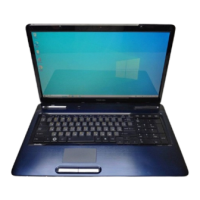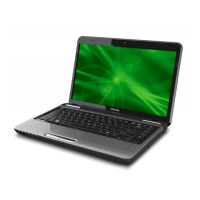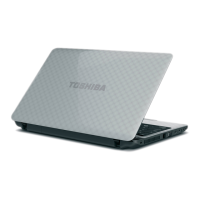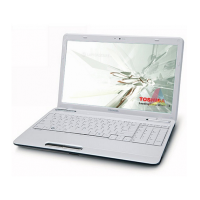
Do you have a question about the Toshiba Satellite Pro L770 and is the answer not in the manual?
| Optical Drive | DVD SuperMulti Drive |
|---|---|
| Processor | Intel Core i3/i5/i7 |
| Chipset | Intel HM65 Express |
| RAM | Up to 8GB DDR3 |
| Storage | 320GB/500GB/750GB HDD |
| Display | 17.3-inch HD+ (1600x900) |
| Graphics | Intel HD Graphics 3000 |
| Operating System | Windows 7 Home Premium |
| Wireless | Wi-Fi 802.11 b/g/n |
| LAN | 10/100/1000 Mbps Ethernet |
| Ports | HDMI, VGA, RJ-45, headphone/microphone combo jack |
| Battery | 6-cell Lithium-ion battery |
| Weight | 2.8 kg (6.17 lbs) |
Details the hardware, documentation, and software included with the computer.
Provides instructions for connecting the AC adaptor to power and charge the computer.
Explains how to open the computer's display panel for optimal viewing.
Guides on how to turn the computer on, start it for the first time, and turn it off.
Identifies components on the front of the computer with display closed.
Details ports and features on the left side of the computer.
Details ports and features on the right side of the computer.
Identifies components on the underside of the computer.
Describes internal components like CPU and Hard Disk Drive.
Explains how to use the touch pad for pointer control and its buttons.
Details keyboard layout, indicators, and function keys like F1-F9.
Describes keyboard shortcuts for system functions like brightness, volume, and sleep.
Provides instructions for using optical drives, including inserting and removing discs.
Covers memory media slots, types, and safety precautions for handling cards.
Guides on connecting an external analog monitor via the RGB port.
Explains how to connect a monitor or TV using the HDMI out port.
Details audio controls like Volume Mixer and Microphone Level settings.
Introduces pre-installed utilities like Power Saver, PC Diagnostic Tool, and Face Recognition.
Highlights unique or advanced features for convenience, like Hot Keys and Power Options.
Explains Sleep and Charge function status and USB port compatibility.
Guides on configuring hardware settings via the HW Setup program.
Describes how to restore the system using recovery media or partition.
Details power states and indicator lights for AC adaptor and battery status.
Provides safety precautions for handling, charging, and replacing the battery pack.
Offers tips to extend battery life based on usage and settings.
Explains computer power modes like Shut Down, Hibernation, and Sleep.
Offers guidelines on how to approach and diagnose problems systematically.
Covers issues related to software, hardware, and system components.
Addresses problems with Power, Keyboard, Display, Hard Disk Drive, and Optical Disc Drive.
Provides solutions for common Touch Pad and USB device problems.
Information on how to get additional help from TOSHIBA Support.
Summarizes the computer's physical size and operating environmental conditions.
Details the AC adaptor and computer power specifications.
Explains factors affecting CPU performance and system shutdown conditions.
Discusses how main system memory is used and limitations for 32-bit systems.
Explains variables affecting battery life and capacity.
Details compatibility and standards for Wireless LAN and Bluetooth devices.
Discusses radio frequency energy and safety recommendations for wireless products.
Provides definitions for common abbreviations used in the manual.











